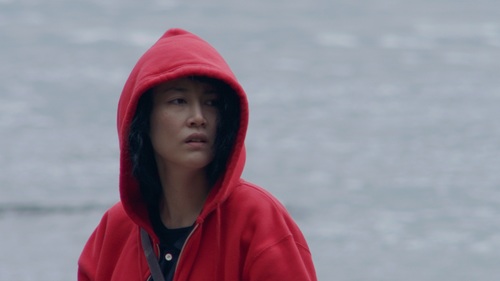Director David Zellner and Rinko Kukuchi attempt to conjure Coen brothers’ chemistry in the land of Marge
Kumiko, The Treasure Hunter
Starring: Rinko Kukuchi
Directed by: David Zellner
Running time: 105 minutes
Rating: 3 stars out of 5
(In English and Japanese with English subtitles)
By Jay Stone
It starts — as so many films do these days. What’s the deal here? — with the words, “This is a true story.” Except the writing is fuzzy and the soundtrack crackling, as if it was one of those Japanese horror movies about haunted videos. It turns out that the “true story” epigram has been borrowed from the 1996 Coen Brothers movie Fargo: we’re watching a video, a sort of haunted video, come to think of it that forms the subtext of Kumiko, The Treasure Hunter. In many ways — as in so many films these days. What’s the deal here? — it’s a movie about a movie.
Fargo is not “true” at all, of course, except in the sense that it is an accurate representation of the skewed Coen Brothers universe and probably has formed the most lasting public impression of the snowbound North Dakota landscape where it is set. Kumiko is also not “true,” except insofar as it is a version of an urban legend surrounding a 2001 incident in which a Japanese tourist was found dead in the very region where Fargo was set.
But what is “true,” after all? That’s one of the questions in Kumiko, which stars Rinko Kukuchi (the deaf girl in the 2006 film Babel) as a painfully shy, depressed, introverted and possibly mentally ill young woman who works as an “office lady” — part personal secretary, part oppressed intern — for a big soulless company in Tokyo. Her only interests in life, aside from quietly hating her boss, are Bonzo, the timid rabbit she keeps in a cage (an animal, you notice, much like Kumiko herself) and the scene in Fargo where Steve Buscemi’s character buries a fortune in ransom money under a pile of snow beside a fence.
If you’ve seen Fargo recently, you’ll recall that the money is never recovered: it’s one of the twists in that movie that so many people die for a fortune that disappears. But Kumiko believes that Fargo is real, and she obsessively watches her video, measures the TV screen to see how far apart the fence posts might be, and eventually embroiders a treasure map with a thread and needle.
“I am like a Spanish conquistador,” she explains in a rare moment of what passes for lucidity. She is seeking “untold riches hidden deep in the Americas,” or rather, in this case, in the Coen brothers’ screenplay.
Kumiko was made by another pair of filmmaking siblings, David and Nathan Zeller, who live in Austin, Tx., home to this kind of indie quirkiness. Kumiko is partly a culture-clash drama and partly an investigation of the power of the movies, and what it lacks in narrative thrust — Kumiko is far too passive a heroine to pull us into the movie — it makes up for in originality.
Even there, though, you get the feeling that you’re watching a copy of a video, as it were. Kumiko’s adventures in “the new world,” as it’s called, are populated by a cast of characters — including a policeman, played by the director, who has the small-time Minnesota decency and wide-eyed naiveté of one of Fargo’s hick-town cops — who lack the edgy eccentricity the Coens give their people. It’s like a dress rehearsal for the (un)real thing. “How do you go Fargo?,” Kumiko asks them in her limited English, and she ends up wandering along windblown highways and over snowy fields wrapped in a purloined motel blanket, an innocent abroad.
Her forlorn figure is set against the wintry cold as a sort of symbol of alienation, if not outright schizophrenia, and cinematographer Sean Porter (who also shot the mumblecore classic Humpday) melds the haunting contrasts to create some beautiful compositions. It doesn’t really amount to much, however: the portrait of a loopy outsider mostly serves to remind us that it might be time to watch Fargo again, just to get a glimpse of the true story.
-30-


No Replies to "Kumiko: The flip side of Fargo with a Japanese accent"